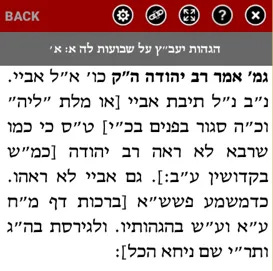Abaye cannot speak with Rav Yehuda
In Shevuot 35a, Rav Yehuda says something and Abaye reacts. Then, Abaye revises the statement.
Thus,
גְּמָ׳ ״מַשְׁבִּיעַנִי עֲלֵיכֶם״ – מַאי קָאָמַר? אָמַר רַב יְהוּדָה, הָכִי קָאָמַר: ״מַשְׁבִּיעַ אֲנִי עֲלֵיכֶם בִּשְׁבוּעָה הָאֲמוּרָה בַּתּוֹרָה״; ״מְצַוֶּה אֲנִי עֲלֵיכֶם בְּצַוָּואָה הָאֲמוּרָה בַּתּוֹרָה״; ״אוֹסֶרְכֶם אֲנִי בְּאִיסּוּר הָאָמוּר בַּתּוֹרָה״.
GEMARA: The mishna teaches that if the plaintiff said to the witnesses: I administer an oath to you, I command you, or I bind you, these witnesses are liable for taking a false oath of testimony. The Gemara asks: What is the plaintiff saying? He merely said that he is administering an oath, but he did not say in the name of what he is administering the oath. Rav Yehuda said: This is what the plaintiff is saying: I administer an oath to you with the oath mentioned in the Torah, I command you with the command mentioned in the Torah, I bind you with the bond mentioned in the Torah, and in the Torah all of these include mention of the name of God.
אֲמַר לֵיהּ אַבָּיֵי, אֶלָּא הָא דְתָנֵי רַבִּי חִיָּיא: ״כּוֹבֶלְכֶם אֲנִי״ – הֲרֵי אֵלּוּ חַיָּיבִין; כּוֹבֵל בְּאוֹרָיְיתָא מִי כְּתִיב?!
Abaye said to Rav Yehuda: But according to that interpretation, concerning that which Rabbi Ḥiyya teaches, that if the plaintiff said to the witnesses: I chain you, these witnesses are liable for taking a false oath of testimony, is chaining written in the Torah? Apparently, the reference in the mishna and the baraita is not to similar language in the Torah.
אֶלָּא אָמַר אַבָּיֵי, הָכִי קָאָמַר: ״מַשְׁבִּיעַ אֲנִי עֲלֵיכֶם בִּשְׁבוּעָה״; ״מְצַוֶּה אֲנִי עֲלֵיכֶם בִּשְׁבוּעָה״; ״אוֹסֶרְכֶם אֲנִי בִּשְׁבוּעָה״; ״כּוֹבֶלְכֶם אֲנִי בִּשְׁבוּעָה״.
Rather, Abaye said that this is what the plaintiff is saying: I administer an oath to you with an oath, I command you with an oath, I bind you with an oath, I chain you with an oath. The witnesses are liable in all these cases provided that the plaintiff mentions an oath.
Artscroll notes that Rav Yaakov Emden and Porat Yosef weigh in. Here is Rav Yaakov Emden:
He points out that just as fourth-generation Rava did not overlap with second generation Amora Rav Yehuda, neither would Rava’s contemporary Abaye. Therefore, get rid of Abaye in the posing of the question. [Or alternatively, Abaye can voice the objection, but get rid of the word “to him”, so he is just voicing it.]
Looking at the manuscripts on Hachi Garsinan, I don’t see any that have this. And I’m not sure what he (whoever writes the [] content) means that the word leih is sagur bifnim in manuscripts. Does this mean that it was placed in parentheses? I don’t see it.
Regardless, as I’ve noted in the past about this pattern: this specific pattern of amar leih X … ela amar X might well be an example of pseudepigraphic attribution of a statement to a named Amora X. That is, in our case, Abaye indeed said statement #2. But, to fill in the details of Abaye’s motivation in disagreeing with Rav Yehuda’s statement, the Talmudic Narrator supplies a reason that Rav Yehuda’s statement is perhaps wrong or insufficient. And, it often then places this reason, statement #1, in Abaye’s mouth, as his justification. It is unclear whether they thought the audience would understand it as literally Abaye’s words, or rather that they would understand it as an expansion of the philosophy behind Abaye’s words.




